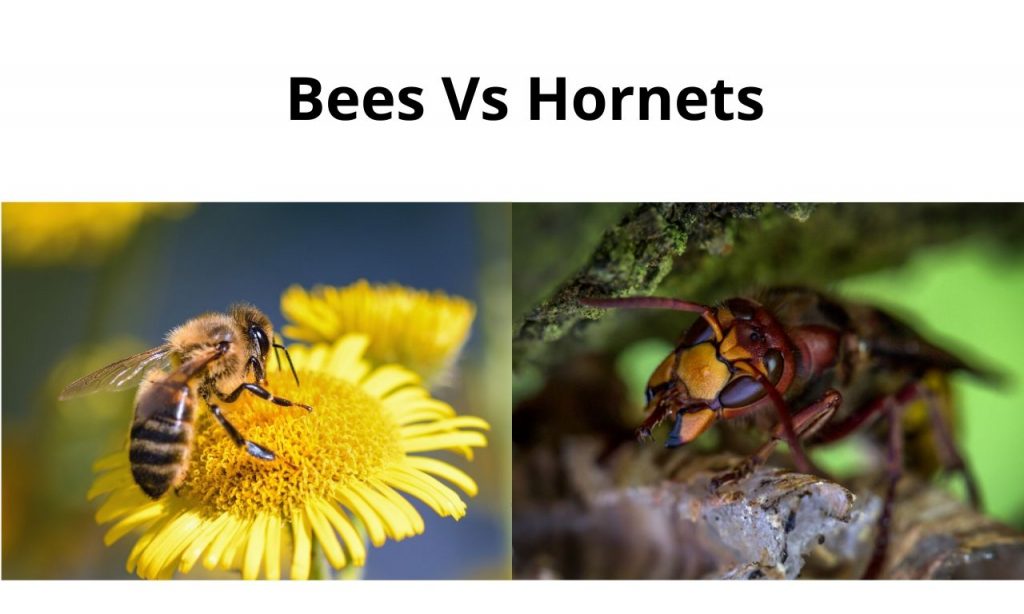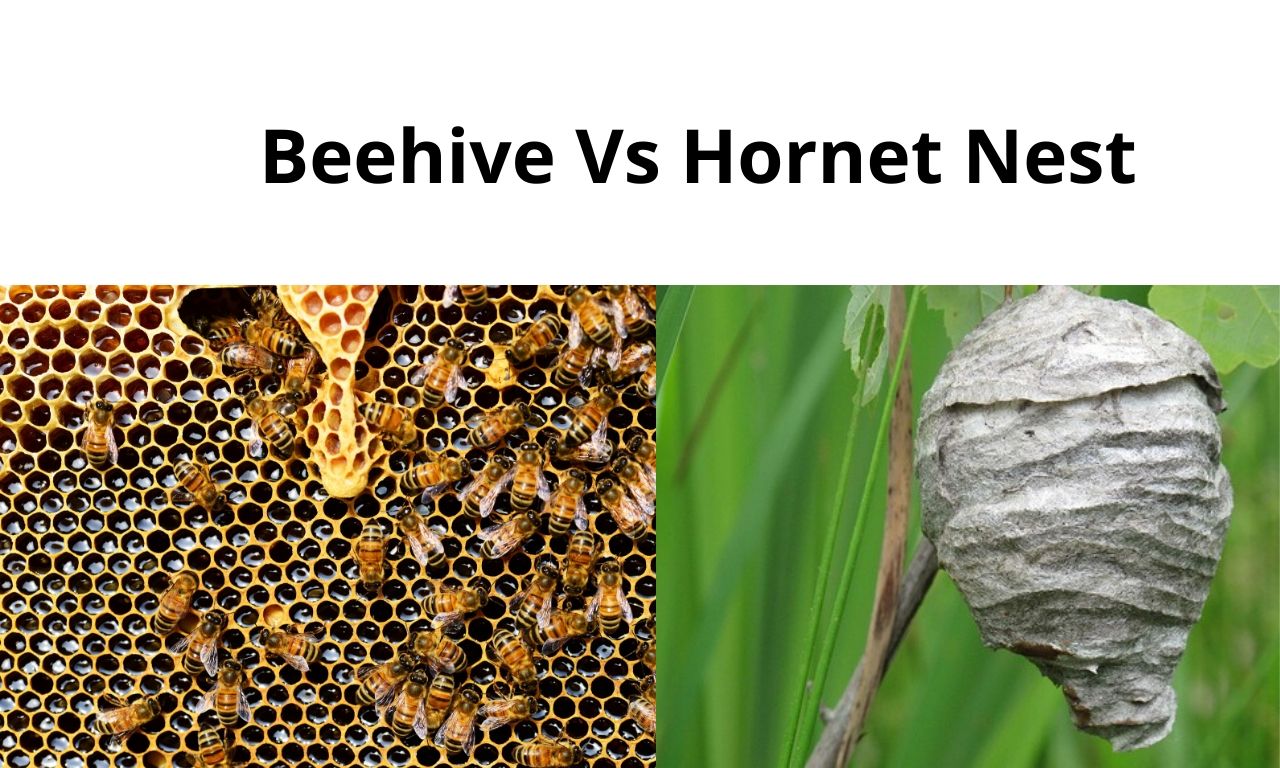
 Bees and hornets are common flying insects, and from a distance, they look similar. They build nests above the ground and live in colonies. However, they are poles apart. Let’s look at their similarities and differences across their order, appearance, characteristic, feeding, aggressiveness, sting, and usefulness.
Bees and hornets are common flying insects, and from a distance, they look similar. They build nests above the ground and live in colonies. However, they are poles apart. Let’s look at their similarities and differences across their order, appearance, characteristic, feeding, aggressiveness, sting, and usefulness.
Bees Vs Hornets: If you compare all the aspects of bees and hornets then bees will win however, in a fight a hornet can easily kill a bee. Hornets are much bigger in size and are much stronger. They can take down even the most aggressive bee i.e. killer bee.
Continue reading to know in details.
Order
Hymenoptera order consists of over 150,000 living species and over 2,000 extinct ones. Apocrita is one of the two suborders of Hymenoptera, the other being Symphyta. Bees and hornets belong to the Apocrita order of insects.
Appearance
Bees: Though they look similar to hornets from a distance, they are comparatively small in size and fuzzy looking. The fuzziness occurs due to its tiny hairs on its round body. These hairs help it to collect pollen from flowers. The most common type of bees is the honey-bee, which grow up to half an inch in length. They are generally yellow, with black and yellow stripes. Bumble-bee, on the other hand, is more robust and can reach up to one and a half-inch in length. They make noise while in flight!
Hornets: They are generally black with white and grey stripes. Their length is around three fourth inch, while some varieties called the yellow-jackets to reach up to two-inch in length. Some are reddish-brown too! Their heads are broad with a swollen abdomen. However, they are more slender looking, compared to the bee.
Distribution
Bees: Found across the world, except Antarctica. There are nearly 16,000 known species of bees.
Hornets: These are mostly in the northern hemisphere, and each region has its varieties of hornets. There are 22 known varieties, found worldwide.
Characteristics
Bees: Have large compound eyes, which covers most of their head. Their antennae detect touch, smell, and taste. Its mouth gets used for chewing and sucking of nectar. Their front legs have ‘combs’ to clean their antennae, while most bees have hind legs with pollen baskets. Bees’ legs are wide, flat, and hairy. Their abdomen has nine segments, of which the last three forms the sting!
Hornets: They have a slender waist and a sting at the end of its abdomen.They have long, thin legs, which are smooth, round, and waxy.
Colonies
Bees: Their average colony size is around 75,000 bees.
Hornets: Their average colony size is around 10,000 wasps or hornets.
Feeding
Bees: They are mostly vegetarian and feed their young ones with nectar and pollen. A small variety of bees also provide insects to their young ones and also are carnivorous, though they are scavengers and don’t kill themselves.
Hornets: Though adult hornets feed on tree leaves and sap, they also prey on other small insects like bees, flies, and other insects. They provide small insects to their young ones, who are carnivorous.
Nest Structures
 Bees: They create their living quarters using wax and are called honeycombs. This is where they live and store nectar. Their hives or homes are hexagonal inside and bag-shaped outside. These homes get built on a tree trunk or roofs of caves.
Bees: They create their living quarters using wax and are called honeycombs. This is where they live and store nectar. Their hives or homes are hexagonal inside and bag-shaped outside. These homes get built on a tree trunk or roofs of caves.
Hornets: Their nests are created using wooden chips and shavings on the tree trunk. These chewed woods and saliva is used to develop comb-like round structures at other available vantage points. Their home is stacked cylindrical-shaped inside.
Aggressiveness
Bees: Generally, do not attack if not provoked. Also, in the absence of a queen bee, other bees feel threatened. They will leave you alone when you are a little distant from their hives.
Hornets: Bald-faced hornets are more aggressive than other types. They attack without much provocation and continue to pursue you even at a considerable distance from their homes. They are known to attack and eradicate a large number of bees and their colonies.
Sting
Bees: When bees sting, they are unable to retract their stinger from their prey. Along with their stinger, they also lose some of their abdominal parts, including the digestive tract. This leads to their death soon after. However, the stinger of bumblebee is smooth and hence can retract after stinging. Thus, the bumblebee does not die after stinging.
Hornet: They can sting repeatedly and don’t die like the bees. This is because they can retract their smaller stinger effortlessly from their prey after each sting. Their sting is more painful due to certain chemicals that are present in their venom. For an allergic victim, their bite could be fatal.
Usefulness
 Bees: They are not only useful to humans but the entire ecosystem. Some areas are:
Bees: They are not only useful to humans but the entire ecosystem. Some areas are:
- As pollinating agents, they cross-pollinate various crops, leading to the availability of food for us all – humans, animals, birds, and insects. This happens when they move from flower to flower to collect nectar, and the pollen gets transferred across plants.
- They are the creators of honey, which gets consumed worldwide.
- Its therapeutic properties add value to its intake. They get widely used for various human illnesses.
- Bee wax is another product contributed by the bees. This has extensive use in cosmetics worldwide.
- They pollinate wild shrubs, flowers, and fruits, adding to the beauty of the landscape.
- Many varieties of trees are also pollinated by bees and other pollinating insects, contributing to the resources of a region.
- Bee-keeping helps in monetizing their output in a sustained manner.
- Bees have much to offer us in terms of imaginative ideas.
- They are exciting subjects of research worldwide.
- They are being trained to sniff out land mines in war zones.
Hornets: They keep the pest insects under control, and are helpful to farmers in infested areas. They pollinate plants and trees like the bees, though they do not possess any pollinating apparatus. However, they don’t produce honey!
Some Similarities Between Bees And Hornets Are:
- Both belong to the same insect order of Hymenoptera.
- Only the females have stings.
- For both stings, wash the area with soap and water. Apply a cold pack or any soothing cream on the wound. Take ibuprofen for pain relief.
- Both pollinate plants and trees, though hornets marginally in comparison to bees.
- They mostly build their colonies above the ground.
Some Facts Concerning These Two:
Bees: They need to gather nectar from two million flowers to produce one pound of honey.
- A bee needs to travel three times around the globe, i.e., 90,000 miles, to make one pound of honey
- On average, a bee makes only one-twelfth teaspoon of honey during its lifespan.
- They visit nearly 100 flowers while collecting nectar.
- They can fly up to 6 miles, at a speed of 15 miles per hour.
- Their brain is as big as sesame seed but can make a complex calculation concerning distance traveled, the route to follow for maximum efficiency, and find their way back to their hives.
- A colony of honey bees consists of 20,000 to 60,000 bees, with one queen, drones and worker bees. All the nectar collecting work gets done by the worker bees, who are all females.
- The queen bee lives long, sometimes up to 5 years, and is the only one who lays eggs. She is most busy during the summer months and lays up to 2,500 eggs a day!
- The male bees, also known as drones, do not do any other work except a mate. They cannot sting, in the absence of a stinger.
- The medicinal property of honey cures sore throats helps in digestion and addresses skin ailments.
- The antiseptic properties of honey help in wound dressing.
- Its natural ingredients of fructose and glucose can easily be digested and hence preferred by sportsmen as energy boosters.
- For over 150 million years, honey bees have been producing honey.
- They are the only insect, which produces edible food for humanity.
- Pure honey lasts for centuries. Its intrinsic properties preserve honey for eternity.
- Their wings beat over 10,000 times per minute to create the buzzing sound
- They are intelligent enough to indicate to other workers in their colony about a new source of nectar by a form of dance called the ‘waggle dance.’
- Honey has the property to attract and retain moisture. This makes it an essential ingredient for skin treatment over the ages!
- It’s antioxidant property, pinocembrin, vitamins, minerals, and enzymes, makes honey a very healthy food for humans.
Hornets: The Asian giant hornet grows up to 2 inches long
- Though they feed on tree sap, fruits and insects, their prime prey are the bees!
- They are active throughout the day, including night time.
- The scout hornets secrete pheromones to inform their fraternity about a beehive find.
- Some honey bees can lure these scouts into their hives and kill it with the combination of heat and carbon dioxide, produced by them.
- Hornets’ colonies last only for one season since the queen leaves her territory to mate with males of other colonies, at the end of every season.
- The queen will feed the larvae chewed bees and saliva, once they get hatched after a few days.
- Hornet workers get created in 2 weeks, who then would be busy creating more cells for the queen to lay eggs.
- In addition to creating new cells, the workers are responsible for feeding the new larvae and protecting their colonies from other pests.
- During the end of its life cycle, the queen will lay fertilized eggs, which would create new queen hornets and unfertilized eggs, which would generate drone hornets, which in turn would mate with these queens.
- The life cycle of a queen is one year, workers live only for one season, while drones die after they have fertilized the eggs.
- The yellow jacket variety of wasps are the most well-known hornets that get easily found.
- Giant hornet sting, especially in the Asian subcontinent, is fatal at times.
- Giant hornets are Japanese delicacy and included in their daily cuisine – both raw and fried.
- The larvae secrete a specific chemical to attract the attention of the worker hornets, who then feed them. This chemical mixture, called VAAM (Vespa amino acid mixture), is now synthetically developed as a famous Japanese sports energy drink.
- Hornets are attracted to the smell of human food and hence are present in homes and parks.
Conclusion
Though bees and hornets look very similar from afar, they are very dissimilar in terms of their various characteristics and social behavior. In conclusion, bees win hands down over several aspects over the hornet!
Welcome to my blog. I have been doing pest control for years since my house, garden and pets were always attacked by various kinds of pests and as a result I had to know proper pest control techniques that works. In this blog I share all the tips and tricks that I know and I hope you’ll find it helpful.
